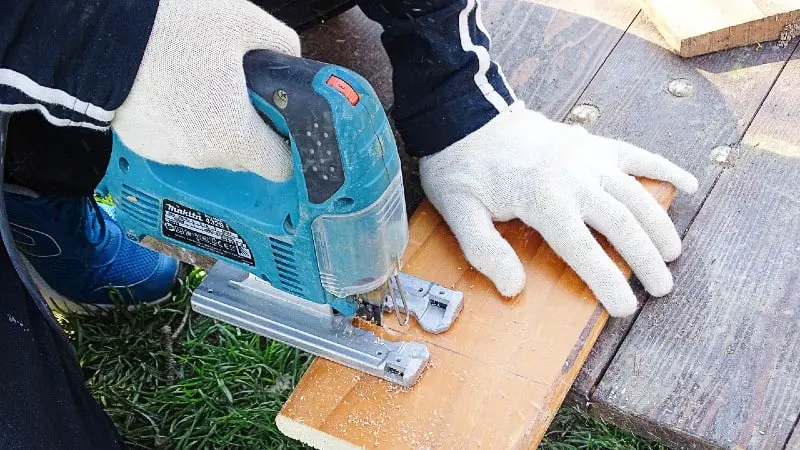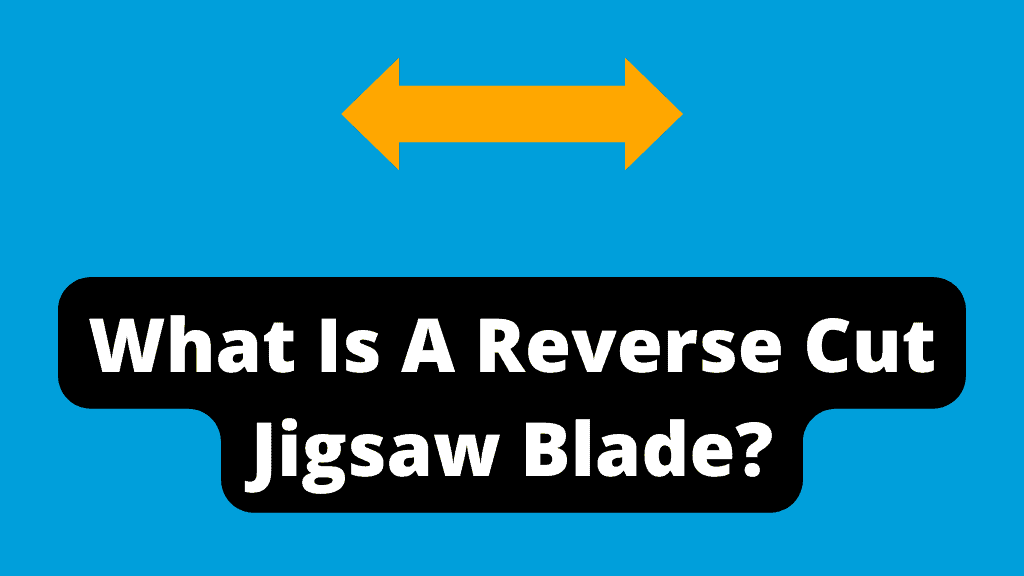The jigsaw is a very flexible and versatile tool. However, the blades do break on occasion and need to be replaced. It’s clear that many different types are available for sale. One type that caught my attention is the “reverse cut” blade. I wasn’t sure what that type did, so I did a little research. This is what I found out:
The jigsaw blade cuts by moving up and down. With the normal blade, the saw cuts on the upstroke. With a reverse cut blade, the cut is made on the downstroke. This leads to less tear-out, chipping, and splintering on the visible surface of the wood. However, the saw will be harder to control with a reverse cut blade.
Let’s look into what that means and see if this blade type is right for your project:
Table of Contents
- How does a jigsaw cut wood?: What Is A Reverse Cut Jigsaw Blade?
- Why use a reverse cut blade?
- Reducing tear-out, chipping, and splintering without a reverse cut blade
- Do reverse cut blades come in u-shank or t-shank?
- What are different jigsaw blades used for?
- Conclusion
How does a jigsaw cut wood?: What Is A Reverse Cut Jigsaw Blade?
When you use a jigsaw, its blade moves up and down along a line in order to cut the wood. In contrast, circular saw blades move around in circles as they do their work.
Note: This post may contain affiliate links. If you purchase a product through an affiliate link, I’ll earn a commission, at no cost to you. To find out more, see my full disclosure.
An upstroke is the movement of a jigsaw blade as it lifts upwards. A normal jigsaw blade has teeth that point upward, so when you use it to cut wood, its teeth will slice into the wood on the upstroke. This link shows normal jigsaw blades on Amazon.
The upstroke produces a force pushing the saw base into the workpiece. As a result, the saw is easy to control.
With a reverse cut blade, the teeth point downward and the saw cuts on the downstroke. This forces the saw upwards, away from the workpiece. The operator may need to push the saw down. This link shows reverse cut blades on Amazon.

Why use a reverse cut blade?
You might be wondering: Why use a reverse cut jigsaw blade?
When you use a normal jigsaw blade, you’re cutting on the upstroke, which creates chipping and splintering on the side of your workpiece that’s visible to you. This can make your project look messier and less professional.
You can avoid this by using a reverse cut blade in the jigsaw. By cutting on the downstroke, most tear-out will be on the underside of your workpiece—and since that part won’t be visible anyway, no one will know that it isn’t perfectly smooth!

Reducing tear-out, chipping, and splintering without a reverse cut blade
Even when you don’t have a reverse cut blade, there are ways to cut material so the result is neater:
Choose the correct TPI value
Generally, blades with a high TPI (teeth per inch) value will give smoother cuts than those with low values. I wrote another article about the TPI of jigsaw blades.
Cut on the backside
In addition, if possible, you might want to draw your measurement and cutting lines on the backside of each piece – this would be the side that is not visible in the finished project. This will make your finished project look less messy.
Use a sharper blade
A dull blade will make it more difficult to cut through the wood and will cause more splintering and tearing of the fibers. I wrote another article with 31 tips for using the jigsaw.

Do reverse cut blades come in u-shank or t-shank?
If you’re looking for a saw blade, you’ll notice that there are two main varieties: u-shank and t-shank. You might be wondering what “shanks” have to do with saw blades—the shank is the part of the blade that connects to your saw. These varieties are described below:
The U-shank – U-shank blades are the traditional type of blade used by older jigsaws, and they require a set screw to attach them to your saw. This makes them inconvenient because you have to use an Allen wrench or another tool like that to install and remove them from your saw.
The T-shank – The majority of modern jigsaws accept t-shank blades, which means you don’t need to use a tool to change them out. You can change blades quickly and easily! Some t-shank jigsaws can eject your blade when you need to change it. This feature is nice when the blade is hot and you don’t want to touch it directly.
Reverse cut blades come in both u-shank and also t-shank varieties. However, it’s easier to find t-shank blades in the hardware store since most modern jigsaws use that type of shank. Nevertheless, here is an example of a reverse cut blade with a u-shank on Amazon.

What are different jigsaw blades used for?
Jigsaw blades are made to cut many different materials and each has its own unique set of benefits and drawbacks. Some are better at cutting through metal, while others excel at cutting curves or intricate shapes. The right blade can make the difference between an easy project and a difficult one, so choosing wisely is key. This section will help you find the right blade for your project, whether that means choosing between a standard or reverse-cut blade, or finding the best blade for your specific needs. This is a list of some of the many different blades available today:
Metal cutting blade – Metal cutting blades are used to cut through sheet metal, thin pieces of metal, and other materials. These blades have a high TPI value, which means they have many teeth per inch of the blade. These are similar to hacksaw blades but are made for use in power tools. This blade on the Amazon site cuts metal.
Knife edge blade – Knife edge blades are a great option for DIYers and those new to woodworking. They are designed for fast, coarse cuts in soft materials, like cardboard, leather, carpet, and polystyrene. This link shows a knife edge blade on Amazon.
Plunge cutting blade – When starting a plunge cut, tilt the blade of your saw downward into the wood. This is an ideal way to make holes for outlet boxes or light fixtures in interior walls. Make sure that the blade is at full speed before it contacts the wood so that the cut is successful. If not, you risk snapping the blade. This link shows a plunge cutting blade on Amazon.
Carbide grit blade – This is a great blade to use when you need to cut hard materials like ceramics, fiberglass, and glass. It will deliver clean cuts that don’t require a lot of finishing work. See a carbide grit blade on Amazon.
Narrow blade – A narrow blade is perfect for intricate scroll cuts. This type of blade can also be used for cutting veneer and molding. This link shows a narrow blade on Amazon.
Diamond blades – Diamond blades are a good choice for cutting tile, marble, granite, and similar materials. They have diamond grits bonded to metal blades, making them both durable and effective at creating smooth cuts in these materials—ideal for DIYers! See a diamond blade for jigsaws on Amazon.
Reverse cut blade – The reverse cut blade is perfect for cutting laminated wood, hard and soft wood, and plastics. The normal cut on an upstroke can leave chipping on the visible surface of your project. This is reduced with a reverse cut blade because it cuts on downstroke rather than upstroke. Here is an example of reverse cut blades on Amazon.

Conclusion
So there you have it! A reverse cut jigsaw blade is a blade with teeth that cut on the downstroke, creating less tear-out and splintering than a regular jigsaw blade. For more information, see another article I wrote called: What is a Jigsaw?
It’s a great option for those who want to achieve a clean, smooth cut without any chipping or splintering on the visible surface of the wood. However, this comes at the cost of more effort and control with your saw.
Reverse cut jigsaw blades are available at many hardware stores and online retailers. They come in both u-shank and t-shank varieties. I wrote another article about t-shank and u-shank blades.
I know you have heard this many times before: Make sure to use the right tools for the job. In the context of jigsaw blades, we are talking about choosing the right blades for your project. Reverse cut blades can be a lifesaver for work with laminates having brittle surfaces subject to chipping. Some other blades for a jigsaw include:
- High TPI blades
- Low TPI blades
- Wood cutting blades
- Metal cutting blades
- Combination blades for both wood and metal
- Blades for tile, porcelain, cement, and similar materials
- Blades for plastics
- Blades for ceramics
- Knife edge blades
Did you enjoy reading this article? If so, you might be interested in visiting my Pinterest profile. It contains pins about woodworking, DIY & Crafts, Tools, Projects, Hardware, and related topics.


